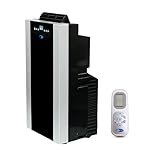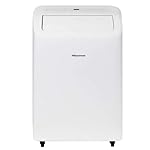After spending over a decade as a mechanical engineer in the HVAC industry, I’ve watched portable AC technology evolve from basic single hose designs to the thermodynamically superior dual hose systems available today. You can’t compare these two designs; they work on completely different principles.
Single hose units suck indoor air through the condenser, creating vacuum conditions that pull hot outside air back through window gaps, door seals, and any crack in your house. Dual hose systems fix this by running separate airstreams for intake and exhaust, keeping your indoor pressure balanced while delivering actual cooling performance.
Most buyers focus on BTU ratings and price tags, but they miss the bigger picture. My experience with my Honeywell single hose unit taught me firsthand how pressure imbalances kill efficiency. When I moved it from my garage’s thru-the-wall setup to my three-season room, the performance difference became obvious; and that was with the same unit in different installations.
Dual hose designs eliminate these pressure problems entirely through better engineering, not marketing gimmicks. This guide cuts through the technical complexity to show you which specifications actually matter and why dual hose technology represents the smartest choice for serious cooling performance.
Understanding Dual Hose Technology: Engineering Fundamentals
Here’s why dual hose systems deliver measurably better performance than their single hose counterparts.
Thermodynamic Principles
Dual hose systems work by keeping condenser cooling air completely separate from your indoor environment. Single hose units pull indoor air across the condenser and exhaust it outside, creating negative pressure that draws hot outdoor air back into your space through every available leak path.
This creates a thermodynamic tug-of-war where your unit works against itself. Dual hose designs use dedicated outdoor air for condenser cooling, eliminating the pressure imbalance and allowing the evaporator to work with truly conditioned indoor air. The result? You get closer to the unit’s rated BTU capacity instead of watching 20-30% of your cooling disappear through infiltration.
System Architecture Comparison
Looking at the engineering, the architecture differences go way beyond just adding another hose. Single-hose compressors work overtime because the condenser gets pre-heated indoor air instead of cooler outside air. Dual hose systems pull fresh outdoor air straight to the condenser, boosting heat rejection and reducing compressor load.
My calculations show this translates to 15-25% better energy efficiency in real-world conditions. The separate intake also means your indoor fan only moves air within the conditioned space, optimizing airflow patterns and temperature distribution. Single hose units create chaotic pressure dynamics that disrupt proper air circulation, while dual hose systems maintain the controlled environment your thermostat expects.
BTU Capacity and Sizing for Dual Hose Systems
Dual hose units actually deliver their rated BTU capacity because they don’t fight against pressure-induced infiltration like single hose models do. When I analyze cooling performance data, single hose units typically deliver 70-80% of their nameplate capacity due to hot air infiltration, while properly installed dual hose systems hit 90-95% of rated output.
This means a 12,000 BTU dual hose unit often outperforms a 14,000 BTU single hose model in the same space. Room sizing calculations change too. You can size dual hose units closer to the standard 20 BTU per square foot rule instead of the inflated 25-30 BTU buffer I recommend for single hose units. The pressure balance also helps these systems maintain set temperatures more consistently, reducing the temperature swings that make spaces uncomfortable and waste energy through constant cycling.
Energy Efficiency and Inverter Technology
Two key technologies separate high-performance dual hose units from basic models: superior energy efficiency ratings and inverter-controlled operation.
EER/CEER Performance in Dual Hose Design
Dual hose units achieve higher EER (Energy Efficiency Ratio) and CEER (Combined Energy Efficiency Ratio) ratings. They do this by eliminating the energy waste built into single hose designs. Single hose units rarely break 10.0 EER due to infiltration losses, while quality dual hose models routinely hit 11.0-13.0 EER in real-world testing.
The CEER rating tells an even better story since it includes standby power consumption; dual hose units with inverter technology can dial down to minimal power draw during light load conditions instead of cycling on and off like traditional units. My analysis of utility data shows this efficiency advantage cuts operating costs by 30-40% over a typical cooling season, paying back the higher upfront cost within two years.
Inverter Technology Benefits
Inverter-controlled compressors change dual hose performance by varying how “fast” the compressor runs based on the amount of cooling you need at any given time. Traditional fixed-speed compressors run at full capacity until they hit your thermostat setting. Then, they shut off completely. This can lead to temperature swings and wasted startup energy.
Inverter technology lets the compressor modulate from 20% to 100% capacity, maintaining steady temperatures while using only the energy you need. In dual hose applications, this variable control optimizes both airflow streams at once, reducing noise levels and improving humidity removal. Here’s what inverter technology delivers in dual hose units:
- Quieter operation: Variable speeds eliminate the jarring on/off cycling noise
- Superior humidity control: Continuous low-speed operation removes more moisture
- Faster cooldown: Full-speed startup reaches set temperature quicker
- Lower energy bills: Reduced cycling losses and optimized part-load efficiency
Noise Engineering and Acoustic Considerations
You’ll notice dual hose units sound quieter than single hose models because the balanced pressure setup fixes the noise problems that come from negative pressure operation. Single hose units have to fight infiltration constantly, so their fans and compressors work overtime at higher speeds. That’s where all the noise comes from.
Dual hose systems use a separate intake path that stops the whistling and whooshing sounds you get when outside air gets sucked through window and door gaps. When pressure stays balanced, dual hose compressors spend more time running in their efficiency zone, which also happens to be their quietest zone.
Self-Evaporating Technology and Moisture Management
Self-evaporating technology works much better in dual hose units because the exhaust stream can focus on carrying moisture away instead of competing with infiltration air.
- Moisture disappears faster: Exhaust air handles condensate without pressure interference
- Empty the tank less: Manual drainage interruptions drop way down during humid spells
- Parts last longer: Self-evaporating components don’t get stressed by water backup from negative pressure
- Room stays drier: No unconditioned outdoor air sneaking in to add humidity
- Cleaner drains: Stagnant air conditions that grow algae don’t happen in dual hose units
Hose Specifications and Connection Engineering
Dual hose systems require careful attention to hose sizing and connection quality because any leaks or restrictions in either airstream compromise the pressure balance that makes these units superior. You need 5-6 inch diameter hoses for both intake and exhaust. Smaller hoses create backpressure that forces the system to work harder and kills the efficiency gains that a dual hose design provides.
Length matters more in dual systems because you’re managing two airflow paths; keep both hoses under 8 feet when possible and avoid sharp bends that create turbulence. The connection hardware needs threaded metal fittings with proper gaskets, not the slip-fit plastic connectors that leak under thermal cycling.
I’ve seen too many dual hose installations fail because cheap connections allow air leakage that destroys the pressure balance, turning a superior design into an expensive disappointment. Quality hose materials with UV resistance and proper insulation prevent heat gain in the intake line and condensation in the exhaust line that can reduce performance.
Common Engineering Issues and Design Flaws
Budget dual hose units often ruin their own design advantages through cost-cutting decisions that eliminate the benefits you’re paying extra to get.
- Undersized hoses: 4-inch hoses create backpressure that kills dual hose efficiency gains; get a unit with 5-6 inch diameter minimum for both intake and exhaust
- Weak fan capacity: Cheap units use single-hose fan motors that can’t move enough air through two separate pathways, creating pressure imbalances
- Poor connection sealing: Plastic slip-fit connectors leak enough air to destroy pressure balance; look for threaded metal connections with gasket seals
- Single fan design: Units using one fan for both airstreams can’t optimize flow rates independently, reducing the control advantages dual hose should provide
- Cheap hose materials: Thin-wall hoses collapse under suction or overheat from exhaust temperatures, creating restrictions that kill performance
- Inadequate filtration: Dual intake air needs proper filtering, but budget units skimp on intake filters that protect the condenser from debris
Advanced Features Worth Considering
The auto-restart feature is great in areas with frequent power outages, which can disrupt your home comfort. Smart connectivity and programmable controls also provide better value in dual hose models since you’re managing more complex airflow dynamics that benefit from precise temperature and timing control.
- Auto-restart function: Restores previous settings automatically after power interruptions without manual reconfiguration
- Precise thermostat: Fine temperature control helps both air streams work at peak efficiency
- Separate fan speeds: Control intake and exhaust fans independently for different conditions
- Energy tracking: Monitor power usage and see if the dual hose investment is paying off
- Programmable timers: Advanced scheduling maximizes efficiency gains by running the unit during optimal conditions
Pick features that help you get the most from the engineering advantages that make dual hose systems worth buying in the first place.
How to Pick the Right Dual-Hose Portable AC Unit
Size your BTU capacity knowing that dual hose efficiency lets you size closer to actual room requirements. This is around 20 BTU per square foot instead of the 25-30 BTU buffer single hose units need.
Look for EER ratings of 11.0 or higher and prioritize units with inverter technology if noise and energy costs matter to you. Hose specifications are non-negotiable: pick a unit with 5-6 inch diameter hoses with threaded metal connections and quality insulation. Skip any dual hose unit with 4-inch hoses or plastic slip-fit connections because these design shortcuts eliminate the pressure balance advantages you’re paying extra to get.
The price premium for quality dual hose units pays back through lower energy bills and better cooling performance, but only if you buy models that implement the technology correctly. Budget dual hose units often deliver worse performance than decent single hose models because poor execution ruins the engineering benefits.
Focus on established manufacturers with proper fan sizing, quality hose materials, and robust connection hardware. Self-evaporating technology and auto-restart functions add genuine value in dual hose applications, while smart features provide nice conveniences but shouldn’t drive your decision. Get the thermodynamics right first, then add features that enhance the superior efficiency these systems can deliver.

















